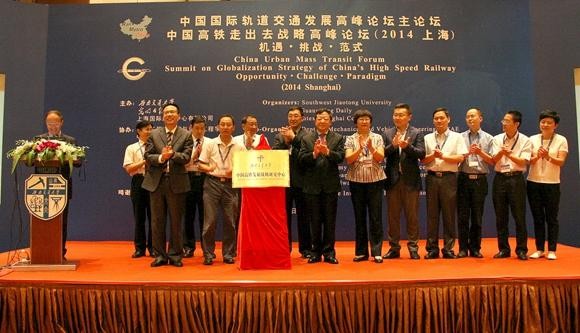Urban rail transit in China has undergone a dramatic development since the founding of new China and now encompasses a broad range of mass transit systems including subway, light rail, maglev, and most importantly the high speed railway.
It is widely recognized that China’s great efforts in developing high speed railway technology have boosted China’s economy and to a certain degree expanded China’s global impact. Questions of how to maintain China’s global impact through a further promotion of high speed railway and how to understand its role within a global context have concerned many Chinese scholars.
SWJTU, Guangming Daily and Shanghai International Expo Center have jointly launched the 2014 China Urban Mass Transit Forum – Summit on Globalization Strategy of China’s High Speed Railway this Tuesday. Experts and scholars at home and abroad shared their visions on the most pressing issues in HSR in terms of opportunity, challenge and paradigm.
Party Secretary of SWJTU Gu Liya claimed that the globalization of China’s HSR conforms to China’s national interest and enables China to engage more with global affairs. “We held the first summit in SWJTU last December, which was praised by the academic circle as a whole. Today, we gather once again. I believe that we will explore more into these pressing issues, maintaining China’s high speed railway of a sustainable and steady development.”
President of SWJTU Xu Fei delivered an in-depth analysis on the available channels for introducing China’s HSR technology to every corner of the world. Xu argued that the ultimate goal of China’s HSR global development is to consolidate China’s harmonious co-existence with other countries, contribute to the restoration of the Silk Road and become the leading country of the land transit system.
“However, the sufficient support, the universal standards in technologies and the available cross-country transit system are the decisive factors for HSR promotion. Meanwhile, differing political systems and market policies across countries may become invisible obstacles, “explained Xu.
Xu also sketched a blueprint for China’s HSR development around the world. “The first step is to connect with the African continent and Asia-pacific railway, Sino-Brazil railway and African railway and this will be our top priority for now. We will then focus on international lines stretching over from central Asia to European continent. The final key part is the lines in American continent.”
“Where there is SWJTU’s scientific research platform and talented people, there is high speed railway.” stated Xu, highlighting SWJTU’s great contribution to HSR development.
Several research institutes were unveiled in this form, such as the China High Speed Rail Development Strategy Research Center of Southwest Jiaotong University, Shanghai Institute of Southwest Jiaotong University, and SWJTU Rail Transportation Research Institute (Shanghai) Co. Ltd.Urban rail transit in China has undergone a dramatic development since the founding of new China and now encompasses a broad range of mass transit systems including subway, light rail, maglev, and most importantly the high speed railway.
It is widely recognized that China’s great efforts in developing high speed railway technology have boosted China’s economy and to a certain degree expanded China’s global impact. Questions of how to maintain China’s global impact through a further promotion of high speed railway and how to understand its role within a global context have concerned many Chinese scholars.
SWJTU, Guangming Daily and Shanghai International Expo Center have jointly launched the 2014 China Urban Mass Transit Forum – Summit on Globalization Strategy of China’s High Speed Railway this Tuesday. Experts and scholars at home and abroad shared their visions on the most pressing issues in HSR in terms of opportunity, challenge and paradigm.
Party Secretary of SWJTU Gu Liya claimed that the globalization of China’s HSR conforms to China’s national interest and enables China to engage more with global affairs. “We held the first summit in SWJTU last December, which was praised by the academic circle as a whole. Today, we gather once again. I believe that we will explore more into these pressing issues, maintaining China’s high speed railway of a sustainable and steady development.”
President of SWJTU Xu Fei delivered an in-depth analysis on the available channels for introducing China’s HSR technology to every corner of the world. Xu argued that the ultimate goal of China’s HSR global development is to consolidate China’s harmonious co-existence with other countries, contribute to the restoration of the Silk Road and become the leading country of the land transit system.
“However, the sufficient support, the universal standards in technologies and the available cross-country transit system are the decisive factors for HSR promotion. Meanwhile, differing political systems and market policies across countries may become invisible obstacles, “explained Xu.
Xu also sketched a blueprint for China’s HSR development around the world. “The first step is to connect with the African continent and Asia-pacific railway, Sino-Brazil railway and African railway and this will be our top priority for now. We will then focus on international lines stretching over from central Asia to European continent. The final key part is the lines in American continent.”
“Where there is SWJTU’s scientific research platform and talented people, there is high speed railway.” stated Xu, highlighting SWJTU’s great contribution to HSR development.
Several research institutes were unveiled in this form, such as the China High Speed Rail Development Strategy Research Center of Southwest Jiaotong University, Shanghai Institute of Southwest Jiaotong University, and SWJTU Rail Transportation Research Institute (Shanghai) Co. Ltd.

